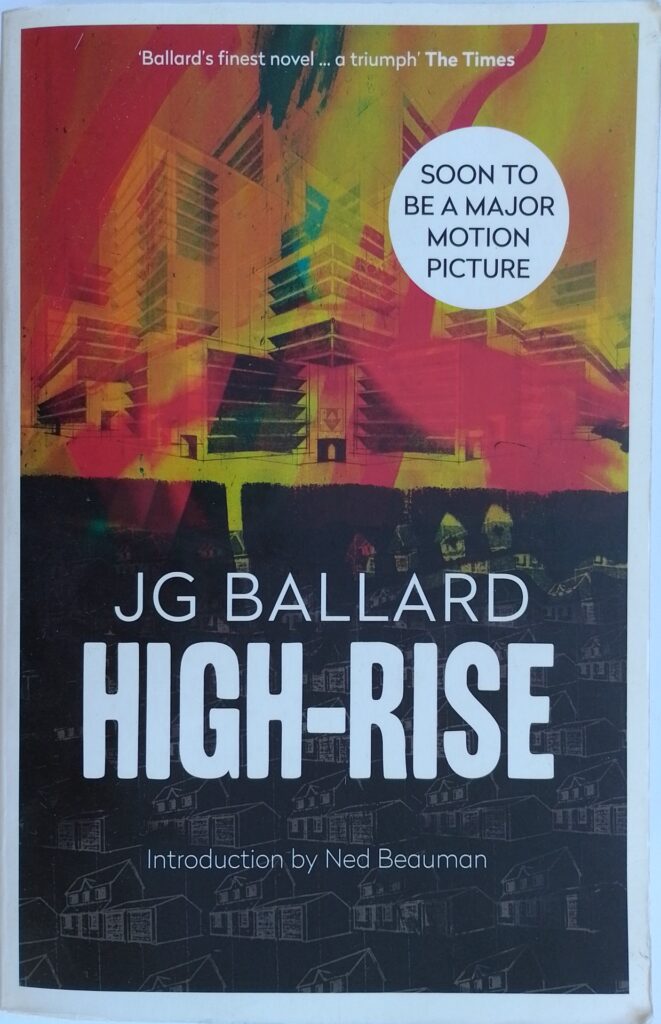First published 1975. Fourth Estate paperback, 2014, pp 253, c.65,000 words.
This is classic Ballard: set in a concrete tower-block in London, the characters never seem to engage one another at an emotional level and there is a steadily growing dystopia. The story concerns three main protagonists: Wilder from floor three, Laing from floor twenty-five, and Royal who occupies the penthouse on the fortieth floor and who was part of the architectural partnership that designed the building. There is the obvious symbolism of lower, middle and upper classes here but all the occupants of the thousand flats in the block are at least moderately wealthy professionals. Yes, the higher up the building, the more expensive the flats, and that is reflected in the subtle distinctions in lifestyles between the floors of the building.
The building itself is the main character. It is postulated that it is responsible for the gradual breakdown that occurs. It sometimes seems to be alive; a body in which its residents are a part: perhaps symbiotic bacteria, or rather unwanted invaders with whom the building is waging war by means of fermenting the turmoil that causes the residents to turn on one another: ‘this was an environment built, not for men, but for man’s absence’ [p28]. That is no plot spoiler because the story opens with the startling line: ‘Later, as he sat on his balcony eating the dog, Dr Robert Laing reflected on the unusual events that had taken place within this huge apartment building…’ [p1].
After the first page, we are back three months earlier when those ‘unusual events’ first manifested themselves. They begin with minor social faux-pas between residents of different floors, slowly leading to separation: ‘people in high-rises tended not to care about tenants more than two floors below them.’ [p2], noted after a champagne bottle explodes on Laing’s balcony, dropped from a party going on somewhere higher up the building. Ballard is having fun with his middle-class readers here: the prevailing view being that high-rises, and their associated problems, were occupied by poorer folk who weren’t inclined to look after their own surroundings. Of course now many of the most expensive properties in the biggest cities are in high-rises, perhaps because in those places they can enjoy cleaner air, more magnificent views and look down on those less fortunate than themselves.
There are some finely crafted sentences here that help develop the surreal feel that Ballard is creating: ‘the ragged skyline of the city resembled the disturbed encephalograph of an unresolved mental crisis.’ [p5]. There is a feeling of growing separation between the high-rise and the rest of the world that begins early: ‘Each day the towers of central London seemed slightly more distant, the landscape of an abandoned planet receding slowly from his mind.’ [p5], and continues to build. The high-rise is self-contained; there is no need to go outside, except for work, and gradually the residents find it harder and harder to leave the building, eventually becoming permanently entombed, perceiving that the only real events are taking place within it. [p80]
The floors begin to separate into distinct groups, ganging up to defend their own and raid the others. It starts with irritations about building service failures and degenerates. Morality gets distorted until there is a type of warfare between the floors. But the spiral continues: men and women become separated, cohesion within floors breaks down. Like Lord of the Flies, without controlling outside forces the decent continues into barbarism and anarchy where the only right is might.
Ballard is superb at spinning sentences that glow with layers of meaning and almost poetic expression: ‘In the future, violence would become a valuable form of social cement’ [p128] – echoes of his novel Crash. ‘All the events of the past few months made sense if one realised that these brilliant and exotic creatures had learned to open the doors.’ [p191] (Of their cages? Of their minds? Of their moral constraints?), ‘The darkness was more comforting, a place where real illusions might flourish.’ [p194], ‘The same dim light, pearled by a faint interior glow, filled the corridor and elevator lobby, a miasma secreted by the high-rise itself, distillation of all its dead concrete.’ [p213].
There isn’t much of a story here, it’s all about creating an atmosphere, something which is done with great power and invention. It is a book that should be read over a short period of time to allow that atmosphere to build, trapping the reader in the embrace of the high-rise, a place where the rest of the world ceases to be real.
Wikipedia biography of Ballard: https://en.wikipedia.org/wiki/J._G._Ballard
Wikipedia summary of the book: https://en.wikipedia.org/wiki/High-Rise_(novel)
Others’ reviews of the book: https://www.goodreads.com/book/show/12331767-high-rise?ref=nav_sb_ss_1_9
© William John Graham, April 2023

